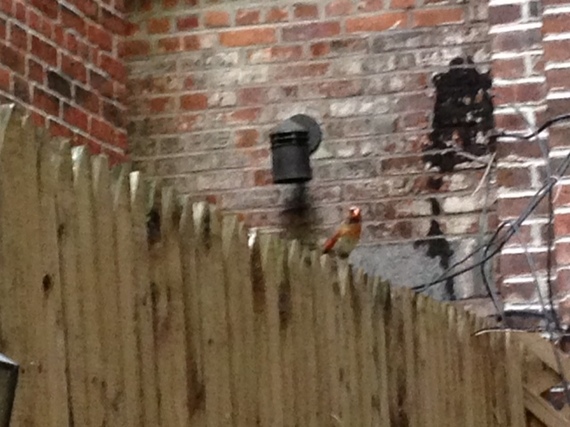The northern cardinal is one of the most familiar birds for residents of New York City, especially those who live near Central Park. The males are characterized by their bright red color, while the females are brownish red.
The cardinals start appearing in spring, just as the last trace of winter snow is melting away. What a joy it is to watch them flit from budding tree to budding tree. They build their nests high above the ground where the cats and other predators can't reach them. Nonetheless, tragedy can strike these beautiful creatures.
In an Upper East Side neighborhood, known as Carnegie Hill, a family of cardinals lives behind several townhouses and buildings. This doughnut hole, as it is called, is made up of a dozen backyards protected by a wall of buildings. Each yard, separated by wooden fences, has a garden and some have trees. This is an ideal home for any bird, which could spend a lifetime in these friendly confines.
But this Garden of Eden can be treacherous as well. High winds, associated with thunderstorms and heavy rain, can shake the smallest and least experienced bird from its perch. And so it did this past weekend. A baby redbird fell to the ground and landed at the base of our building, on a glass atrium.
Its parents spent hours frantically looking for their child. Their chirping was loud and desperate. Drawn by the noise, our dogs peered out of the window and watched with fascination as the birds flew from tree to railing, yelping loudly while looking everywhere for their baby. Finally, they spotted the chick on the atrium and raced to its rescue.
As the mother approached her child, she realized that she could do nothing but check on its condition. The baby was too young to fly, and too big to lift. As the afternoon wore on, the father jumped above from branch to branch, and the mother continued to call to her baby. But they had no way to save their child. It was so painful to watch.
After a couple of hours had passed, I decided to capture the chick and put it in a large plastic container stocked with some food and water. But when I went to collect the chick, it was gone. I searched the area for any sign of the little bird, but I could not find it. I thought, maybe a cat or hawk grabbed the chick? Even if that was the case, the parents continued to circle the area trying to locate their child.
As darkness fell, another major thunderstorm rolled through. The storm cell settled over the city inflicting lightening, loud thunder and heavy rain. I knew that, had the chick survived the day, it would not survive Mother Nature's wrath.
The next morning I went out into the backyard to clear the debris. The parents continued their chirping as they flew around the atrium area. I climbed over the barrier and swept the dead branches from the top of the glass. Suddenly, I saw the dead chick trapped in between wire mesh and the wood walkway. Fate had unfairly dealt its final blow.
Sadly, I removed the bird's body. But the parents clearly didn't understand what had happened because they continued to look for their child until darkness once again fell on the backyards of Carnegie Hill. They again returned early the next morning to renew their search. That's what parents do when they lose a child.


